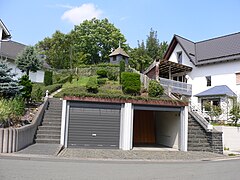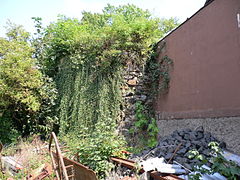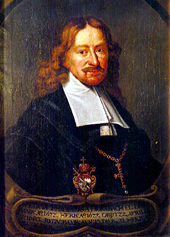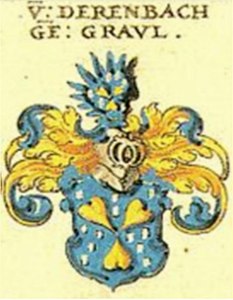Neu-Dernbach Castle
| Neu-Dernbach Castle | ||
|---|---|---|
|
Rest of the southeastern castle wall |
||
| Alternative name (s): | Dernbach Castle | |
| Creation time : | before 1350 | |
| Castle type : | Höhenburg, location | |
| Conservation status: | Wall remains | |
| Standing position : | Nobles / knights | |
| Place: | Bad Endbach -Dernbach | |
| Geographical location | 50 ° 46 '50 " N , 8 ° 30' 21" E | |
| Height: | 480 m above sea level NN | |
|
|
||
The castle New Dernbach also castle Dernbach called, which is ruin a hilltop castle on a hill at about 480 meters above sea level in Dernbach , in the municipality of Bad Endbach in the Hessen Marburg-Biedenkopf .
The castle and its owners
The castle was before 1350 by the Lords of Dernbach (noble family) with the support of Haincher line of men of Bicken built and the Landgrave of Hesse to feudal applied, they verlehnte 1350 right back to the "Dernbach" back.
After the more than 100-year-old Dernbach feud (around 1230 to 1336) ended, the Dernbach family left their former headquarters in Alt-Dernbach , a court settlement with a small moated castle , probably just a moth , on the Aar west of Herbornseelbach . Alt-Dernbach, which was first mentioned in 1263, was located at the ford of the "Hohen-Straße" through the Aar, coming from the Schelderwald and leading to Herborn. The Ganerbe von Dernbach also had to sell their extensive possessions and rights in the Herborner Mark to the Counts of Nassau after the feuds ended in 1333 .
The Dernbach family branches who lived at Vetzberg Castle were also among the Dernbacher Ganerbe . They used to be called "von Dernbach", "von Vetzberg" with or without a name addition such as "Rode", "Holzapfel", "Krig" or "Mul".
Kuno von Dernbach married Countess Margarete von Solms in 1354 and received the villages Günterod and Krumbach (Biebertal) as a dowry, with the consent of the Landgrave, and the new village of Dernbach from the Landgrave. Furthermore, after the area of the "Higher Court" Blankenstein (congruent with today's municipality of Bad Enbach) finally came to Hesse , the Dernbacher received goods in the surrounding villages (eleven in Wommelshausen alone ) that had previously belonged to opponents of the Landgrave.
The castle belonged to two branches of the family, namely those "von Dernbach" and those "von Dernbach called Graul" (Grauel / Graul> named name ).
In 1540 Peter von Dernbach called Graul sold his share of the castle to the Hessian landgrave and moved to Wiesenfeld to live with his relative, the Hessian canon Philipp von Dernbach, who had taken over the former Johanniterkommende Wiesenfeld there. The branch of the family that remained in Dernbach, the “von und zu Dernbach”, was already living outside in the castle estate at that time. The castle, which was already old and dilapidated in 1570, continued to deteriorate.
The last of his tribe, who lived at the headquarters in Dernbach was Peter Philipp Friederich and from Dernbach * 1678 (godfather was Peter Philipp von Dernbach gen. Graul , Prince Bishop of Bamberg and Würzburg , honorary title of Duke in Franconia ). He died after a riding accident on January 2, 1729, leaving only one illegitimate son, Johannes Schneider (1706–1791), called "Junker Hans", who lived as a manorial forester in Dernbach. His line has been propagated through his daughter Elisabetha Margaretha to this day.
In 1748 the evangelical branch of the family with the right to live died with the only 40-year-old captain of the guard Friedrich Ludwig Christian von Dernbach . He was married to Amalie von Breidenstein . The couple had no children.
Landgrave Ludwig VIII of Hessen-Darmstadt moved the castle and the associated lands (including the entire district of Dernbach) as a settled fiefdom, converted it into a state domain, built a new manor house in 1750 and leased the lands. The manor no longer exists. The last courtyard buildings, which stood northwest of the castle hill, were demolished in the middle of the 19th century, only a cellar vault remained.
From the former castle complex there are still poor remains of the outer wall and rudiments of two shell towers (corner towers) in the castle wall.
- Remains of the castle complex
Significant family members
Balthasar von Dernbach called Graul (* 1548; † 1605) was a son of Peter von Dernbach called Graul, who moved to Wiesenfeld in 1540. Peter v. D. was a follower of Philip I, the magnanimous, Landgrave of Hesse. After the death of his father, he was baptized as an Evangelical Lutheran and when he was 12 years old he came to live with his uncle, Abbot Wilhelm Hartmann von Klauer zu Wohra (1568–1570), in Fulda . There he was raised Catholic and elected Prince Abbot of Fulda in 1570 at the age of 22 .
His nephew Peter Philipp von Dernbach called Graul (* 1619; † 1683) studied in Rome, was elected Prince-Bishop of Bamberg in 1672 with the additional title " Duke in Franconia " and in 1675 as Prince-Bishop of Würzburg . He attained at I. Emperor Leopold , whom he knew personally from common times as Vizedom the diocese of Bamberg in Carinthia, the professional increase for his family on July 13 1675 in the Empire Freiherr v and for himself and his nephew Johann Otto and Philipp Wilhelm. Dernbach on March 24, 1678 the elevation to the imperial count status , with seat Wiesentheid .
His nephews all died with no surviving descendants. Heiress of the imperial county Wiesentheid (between Würzburg and Schweinfurt) with the extensive property was the 17-year-old Maria Eleonore, née. Countess von Hatzfeld-Gleichen, widow of Johann Otto Graf von Dernbach called Graul zu Wiesentheid. She married Count Franz von Schönborn in 1701 and brought her rich inheritance into the marriage. The Counts of Schönborn thus became the heirs of the Counts of Dernbach.
As a curiosity, it should be noted that the “most venerable bishop of Würzburg and Bamberg”, Peter Philipp von Dernbach, was the godfather of Peter Philipp Friederich von und zu Dernbach , who was baptized as an Evangelical Lutheran on April 14, 1678, in the baptismal register of Hartenroder ( Bad Endbach ) Is called the church book.
- Coat of arms of the Lords of Dernbach
Coat of arms: from and to Dernbach according to Siebmacher's coat of arms book from 1605
Coat of arms: von Dernbach called Gray after Siebmacher's coat of arms book from 1605
Coat of arms of the Counts of Dernbach based on Siebmacher's coat of arms book from 1701
The last Dernbacherin
The last descendant of the Lords of Dernbach, Therese Freiin von Dernbach, from the Catholic line, born in Frankfurt a. M., daughter of Wilhelm August Ludwig Freiherr von Dernbach, died as a married Baroness von Schorlemer on November 1, 1965 in an old people's home in Weilburg. Their only son died in an accident in a French prisoner of war in 1946.
literature
- Horst W. Müller: Dernbach and the "von Dernbach" . Hinterländer Geschichtsblätter, No. 3 and No. 4, 2005 and No. 1 and No. 2, 2006, bulletin of the Hinterlander Geschichtsverein eV, Biedenkopf.
- Georg Wilhelm Sante (Hrsg.): Handbook of the historical sites of Germany . Volume 4: Hessen (= Kröner's pocket edition . Volume 274). Unchanged reprint of the 3rd edition. Kröner, Stuttgart 1993, ISBN 3-520-27403-5 (reprint of the 3rd edition 1976).
- Rudolf Knappe: Medieval castles in Hessen. 800 castles, castle ruins and fortifications. 3. Edition. Wartberg-Verlag, Gudensberg-Gleichen 2000, ISBN 3-86134-228-6 , p. 277.














